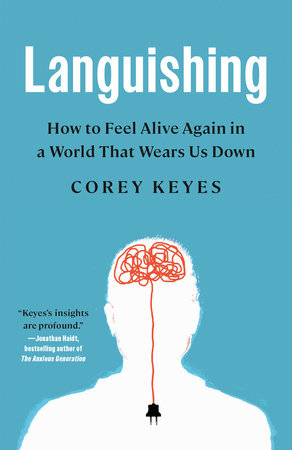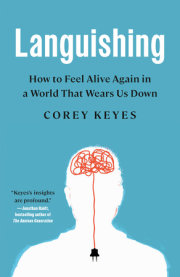[ 1 ]
What Languishing Looks LikePaul was in seventh grade when the trouble started—or at least when the phone calls to his parents from the principal really started to pick up. He and his classmates had all entered middle school the year before, but only for a few hours a day every other week, per the new pandemic restrictions in his district. They’d missed all sorts of milestones—graduation from their elementary school, a summer of fun in between, and an orientation in person at their new school—because of the pandemic raging around them. Most of Paul’s classmates had never even set foot inside the main building before September rolled around.
Any chance of making new friends from the other local elementary schools had slipped away within the first few weeks of sixth grade. If students were learning in person, they were all masked up and leaving before lunchtime; if they were on Zoom, not a single kid kept their camera on the whole day. They’d never even seen their new teachers smile in real life—their faces had been hidden by masks. It felt hopeless and impossible to connect with new people and make a fresh start.
By the time seventh grade rolled around, Paul and his friends, most of whom were left over from his elementary school days, had started making trouble. Small trouble, at first: horsing around in the hallway, speaking out of turn in class, sort of normal seventh-grade stuff, or so his parents thought. But then things started ticking upward. Various destructive TikTok trends were taking off in schools all around the country—paper towel dispensers were getting ripped off walls, horsing around in the hallways turned into full-body tackles, and bathrooms were getting trashed on a regular basis. Paul kept getting caught—for petty vandalism, low-level violence couched as fun. His grades were slipping. Nothing dramatic, such as regularly ditching school, was happening, but his grades had been A’s and B’s, and now there were a whole lot of C’s sprinkled throughout his report card.
At home, things weren’t much more hopeful. Paul was spending hours alone in his room, or if he did come out, he slunk around with his hoodie up, refusing to talk to his parents beyond a cursory hello or goodbye. The silence unsettled them; he could barely meet their eyes at dinner. When he came home from school, he’d climb right into bed with his laptop, saying he had homework to do, but he also seemed to be missing school assignments left and right. He was just so still all the time, his mom told me, as if he didn’t have the energy to move his limbs. It was unnerving. His high-achieving parents were distraught—this wasn’t the kid they knew.
Something about the isolation many kids feel at that time in their lives—things in middle school are, at best, hormonal, confusing, painful, stressful, and anxiety producing—was causing Paul to act out in ways he never had before. One day, to the horror of his parents, they found out that he’d bought a real-looking fake gun and posted about bringing it to school on social media. His classmates had immediately told their teachers, and the school had gone into lockdown mode before 9:00 a.m. It was a joke—of course it was a joke, the gun was just a toy, for God’s sake, and he didn’t even bring it in!—he told his frantic mother. But that joke would get him expelled from school before noon that day.
Why would he do such a shocking thing? Paul’s parents wondered. It was clear that, despite his hiding under his hoodie, he was screaming out to be seen. Underneath his defiant façade, he was feeling powerless and purposeless, more alienated than integrated, his parents began to realize. How, in this nonstop, disorienting, status-obsessed online world, could he feel that he liked most parts of his personality, believe he had something important to contribute to society—beyond an edgy Snapchat post or a dumb hallway prank—or form warm and trusting relationships with others? These are the building blocks of flourishing, and they too often feel hopelessly out of reach for adolescents growing up today.
It makes sense, then, that a languishing teen would rather experience the wrath of their principal, the disapproval of their parents, and the humiliation of getting kicked out of school—than the deadening sentiment of feeling nothing at all.
Who Else Is Languishing?Languishing is particularly likely to occur during three phases of life, affecting as many as 50 to 60 percent of us. The first is adolescence (ages twelve to nineteen)—a difficult time of transition. The second period is young adulthood, between twenty-five and thirty-four, when people are starting their careers and families. Finally, after the age of seventy-five, languishing creeps back up again. Many older adults are not only mourning the loss of loved ones, but also the loss of their former mobility and independence, beset by a variety of ailments and indignities.
In this chapter, we’ll take a close look at how languishing affects us at different ages. As our social and physical environments evolve, what risk factors rise and fall?
Can Young Children Languish?It’s hard to imagine a two-year-old feeling an inner void at such an early developmental stage, how could a toddler be emotionally or cognitively mature enough to show signs of a more serious mental health shortfall? If we understand languishing as the absence of emotional, psychological, or social well-being, however, the sad truth is that yes, young children can demonstrate what researchers call a “failure to flourish.” In fact, in rare cases, toddlers can show signs of major depression, though the symptoms are easy to miss. They might not even seem sad to their parents: Symptoms can range from a “flat affect” to increased clinginess.
In recent years, as the mental health of young adults has deteriorated at alarming rates, clinicians and researchers have begun studying early tells of distress in young children more closely. A growing body of the healthcare community has also shifted toward using holistic measures of health, such as flourishing, that encompass not only physical and cognitive health, but also the social and environmental factors that impact well-being.
A 2022 study of more than eighteen thousand children conducted by the U.S. Census Bureau examined the prevalence of flourishing—and its predictors—in one- to five-year-olds. Parents were asked four questions about their child’s emotional health and functioning. First, does your child bounce back quickly when things don’t go his or her way? Second, would you describe your child as affectionate and tender toward you? Third, does your child show interest and curiosity about learning new things? Fourth, does your child smile and laugh? A child was considered to be flourishing if the answers to all four questions were “always” or “usually.”
The good news was that 63 percent of children met those criteria. But nearly four in ten children were demonstrating a failure to flourish: They lacked resilience, felt disconnected from their parents and others, were uninterested and disengaged, or rarely laughed or smiled.
Children in the study who’d been diagnosed with a physical illness, a developmental disability, or an emotional or behavioral problem were at higher risk. Researchers also found that the failure to flourish was more common among children from socially and economically marginalized families—particularly those experiencing food insufficiency or sleep insufficiency, and whose parents felt a lack of social support.
Young children, more than any other age group, have the natural capacity to flourish. But families need a society that supports them if we, as a society, expect them to nurture that natural capacity. When parents are forced to work multiple minimum wage jobs with unpredictable hours; when they don’t have access to parental leave, limiting bonding time in the early months of a child’s life (and later, opportunities to interact with childcare providers and teachers); when extended family, friends, and others in the local community are overtaxed and underresourced, limiting their availability to help parents in desperate need of support; and when neighborhoods don’t have playgrounds, libraries, and other shared spaces for families to spend time together and form strong support networks, we’re not only failing entire communities, but also our tiniest children.
Copyright © 2024 by Corey Keyes. All rights reserved. No part of this excerpt may be reproduced or reprinted without permission in writing from the publisher.







